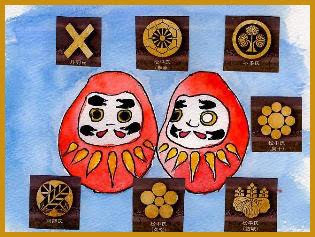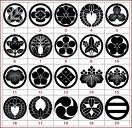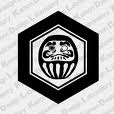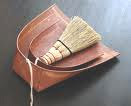:::::::::::::::::::::::::::::::::::::::::::::::::::::::::::::::::::::::::::::::::::::::::::::::::::::
Family Crest 家紋 kamon
Familienwappen

© PHOTO : yotchan
This is a
. Daruma from Shirakawa 白川だるま
:::::::::::::::::::::::::::::::::::::::::::::::::::::::::::::::::::::::::::::::::::::::::::::::::::
Mon (紋), also monshō (紋章) Monsho,
mondokoro (紋所), and kamon (家紋),
are Japanese emblems used to decorate and identify an individual or family. While mon is an encompassing term that may refer to any such device, kamon and mondokoro refer specifically to emblems used to identify a family.
The devices are similar to the badges and coats of arms in European heraldic tradition, which likewise are used to identify individuals and families. Mon are often referred to as crests in Western literature, which is another European heraldic device that approximates the mon in function.
On the battlefield, mon served as army standards, even though this usage was not universal and uniquely designed army standards were just as common as mon-based standards.
Check a long list of famous Japanese crests!
© More in the WIKIPEDIA !
.................................................................................

montsuki 紋付 formal wear with the family crest

CLICK for more photos !
monuwaeshi, mon uwa eshi 紋上絵師 painting family crests
The space for a family crest was usually left white by the cloth dyer and a special painter added the pattern and colors.
Since crests had become quite popular with the townspeople of Edo, they were used not only for official robes but also for decorations of every-day things, even 手ぬぐい tenugui hand towels.
The workshop of a crest painter did not take up much space and could be done in a small home in Edo.
- quote -
There are different styles of mon too. In the picture below, showing three variations of icho (ginko) mon, you can see three versions of a the mon: hinata – full sun (left), kage – shadow (middle), and nakakage – mid shadow (right). The more subtle versions are for slightly less formal occasions. There are also embroidered mon, called nui mon.

hinata mon 日向紋 - - - kage mon 陰紋 - - - nakakage mon 中陰紋
A family may choose a mon that is associated with their family (a family mon is called a kamon) or just opt for one they like instead. They are seen on all sorts of items in Japan: clothing, signs, boxes, ceramics, banners etc.
- source : wafuku.wordpress.com -
上絵の道具 tools of a crest painter

家紋を描くときに使う上絵道具の一部
(左から)from left to right
①分廻し(一本)bunmawashi compass to make a circle
②上絵筆(一本) ③定規 ④丸棒(二本) ⑤小刀(一本)
⑥丸刀(大、小) ⑦摺り込み刷毛(大,中、小) ⑧平刷毛(大、小)
⑨つや刷毛(大、中) ⑩平ゴテ ⑪丸ゴテ ⑫押さえゴテ
- Look at more photos how the tools are used:
- reference source : homepage2.nifty.com/montake/dougu -
「各種紋入れ加工」
「紋直し mon naoshi」「紋入れ・入れ紋 mon ire」「抜き紋 nuki mon」
「摺り込み紋 surikomi mon」「切り付け紋 kiritsuke mon 」
「のり落とし上絵 nori-otoshi uwa-e」「加賀紋 kaga mon」
(Kaga mon is a crest for a "fashionable person" and was very colorful, sometimes with embroidery.)
- with detailed descriptions
- reference source : homepage2.nifty.com/montake/eigyo -
- Check out the detailed page of 紋章上絵師
Itoo 伊藤武雄 Ito Takeo
- reference source : homepage2.nifty.com/montake/mon -
.......................................................................
. Edo craftsmen 江戸の職人 .
mongata shi 紋形師 craftsman making Mon patterns

source : edoichiba.jp.. mongata...
.......................................................................
- quote -
Family-crest master fears he’s one of a dying breed
- Tomoko Ontake - Japan Times -
Dressed in a black kimono and wearing a pair of eye-catching black, triple-framed spectacles, Shoryu Hatoba straightens his back as he sits on the tatami floor of his quaint studio in Ueno, central Tokyo, holding a pair of bamboo compasses fitted with a brush dipped in ink in place of a pencil.
- snip -
But 56-year-old Hatoba is now one of a dying breed of monshō uwae shi (family-crest painters and designers). “I’m an endangered species,” the Tokyo native concedes.
That’s because Japan is now on the verge of losing the tradition of making and preserving the ritual or everyday use of kamon (family crests) — which pretty much everyone in the nation once had. That’s despite the fact that its first known family crests date from the eighth century, when nobles at the Imperial court, and then samurai warriors, started using them as badges of identity or ownership.
But unlike in the West, where family crests were exclusively for the nobility, in Japan their adoption grew exponentially during the Edo Period (1603-1867), and especially during its economically and culturally vibrant golden age known as the Genroku era (1688-1704), Hatoba explains.
Then everyone, but men mostly, started featuring them in whatever design they liked on their kimono. That even included commoners — who mostly had no family names at all until a law in the modernizing Meiji Era (1868-1912) required everyone to have one — though Hatoba says women were generally late to the kamon party, only adopting them at the end of the Edo Period.
- snip -
The crests’ motifs are derived from a wide range of plants, birds and other animals.
- snip -
As a profession, monshō uwae shi demands microscopic attention to detail and command of many sophisticated techniques — not to mention aesthetic sensibilities. And, as Hatoba explains, a crest’s component parts all have to be rendered in a circular design on average only 38 mm in diameter for men’s kimono, and 21 mm for women’s. Interestingly, too, the number of crests on a kimono ranges from one to five — with more crests reflecting an occasion’s greater formality.
Hatoba, who apprenticed under a kamon craftsman for five years before opening his shop, is determined to keep the tradition alive. To do that, he has collaborated with creators and corporations in various genres, featuring kamon designs on everything from bags to boxes of wagashi (traditional Japanese) sweets.
- snip -
- source : Japan Times 2013 -
. Edo shokunin 江戸の職人 Edo craftsmen .
:::::::::::::::::::::::::::::::::::::::::::::::::::::::::::::::::::::::::::::::::::::::::::::::::::

Some crests covered in the Daruma Museum

. Mitsuba Aoi 三つ葉葵 Hollycock of Tokugawa Clan
. Tokugawa Ieyasu 徳川家康
. Tokugawa Mitsukuni 徳川 光圀
The famous inro box with the "mondokoro" from Mito Komon.
.................................................................................
. Asa no ha 麻の葉の家紋 Hemp leaf
. Kuyoo no mon, 九曜の紋
Nine planets, nine deities representing the stars
. Myooga 茗荷 Japanese Ginger
. Rindoo no mon 竜胆 gentian blossoms
. Rokumon sen 六文銭 Six coins of Sanada
:::::::::::::::::::::::::::::::::::::::::::::::::::::::::::::::::::::::::::::::::::::::::::::::::::::

Daruma in a turtle shell crest
亀甲に達磨
:::::::::::::::::::::::::::::::::::::::::::::::::::::::::::::::::::::::::::::::::::::::::::::::::::::
More than 90 Crests from shrines and temples
shinmon 神紋 Shrine crest - jimon 寺紋 Temple crest

京都嵯峨清涼寺
source : secure.ne.jp/~x181007/kamon
:::::::::::::::::::::::::::::::::::::::::::::::::::::::::::::::::::::::::::::::::::::::::::::::::::::::
- quote
A tomoe (巴), also 鞆絵, and tomowe (ともゑ) in its archaic form, is a Japanese abstract shape described as a swirl that resembles a comma or the usual form of a magatama. The origin of tomoe is uncertain. Some think that it originally meant tomoe (鞆絵), or drawings on tomo (鞆), a round arm protector used by an archer, whereas others see tomoe as stylized magatama.
It is a common design element in Japanese family emblems (家紋 kamon) and corporate logos, particularly in triplicate whorls known as mitsudomoe (三つ巴).

A mitsudomoe design on a taiko drum (note the negative space in the center forms a triskelion)
Some view the mitsudomoe as representative of the threefold division (Man, Earth, and Sky) at the heart of the Shinto religion. Originally, it was associated with the Shinto war deity Hachiman, and through that was adopted by the samurai as their traditional symbol. One mitsudomoe variant, the Hidari Gomon, is the traditional symbol of Okinawa.
The Koyasan Shingon sect of Buddhism uses the Hidari Gomon as a visual representation of the cycle of life.
© More in the WIKIPEDIA !
. Hachiman Shrines in the Edo period .
- quote
Okinawan Symbols and History of the Hidari-Gomon
The Hidari Gomon and it was once the Royal crest of Ryukyu Kingdom in Okinawa. In Japanese it is called the Hidari mitsudomoe and is a common design element in Japanese family emblems (家紋) and corporate logos. The Hidari Gonon is the primary traditional symbol of Okinawa. It is unclear who used the symbol first but it has special significance to the Okinawan people especially those practicing the ancient art of Okinawan Karate. I have heard a couple different interpretations of the meaning of the symbol so their may be more than one definition for the symbol.
The Koyasan Shingon sect of Buddhism which came from China to Japan uses the Hidari Gomon as a visual representation of the cycle of life. Others believe that the symbol is Shinto related because in Shinto mythology the symbol is often used to signify the structure taking place between three worlds. Such worlds include heaven, Earth, and the Underworld.
One explanation that was particularly interesting to me was the Okinawan folktale where they interpret the "Hidari Gomon" as representing loyalty, heroism, and altruism to a proud island people and their descendants. They believe it to be expressed through a past full of struggle and hardship, but also a willingness to face the difficulties the ahead no matter what the cost.
snip

Later, back in the Ryukyu Kingdom, the envoy described the death of three warriors to the King. The King after hearing the story of the Ryukyu guards deaths had up the Hidari-Gomon drawn up to symbolize their heroic action. The symbol is said to portray the three Ryukyu warriors spinning around in the pot giving their lives for the greater good of the people. The symbol has since become the symbol of the Ryukyu Kingdom, a symbol which can now be found just about everywhere in Okinawa.
Many Karate dojos have also incorporated its use into the symbols they use to represent their particular style of the ancient Okinawan art of Karate
- source : chicagookinawakenjinkai.blogspot.jp
.......................................................................
- quote -
tomoemon 巴文
1 - Also tomoe 巴. A pattern of one or more curled tadpole shapes inside a circle. The pattern is also called right tomoe, migidomoe 右巴, or left tomoe, hidaridomoe 左巴, depending on the direction in which the pattern curves. When the comma shapes are placed in opposite directions, the term kaeruko domoe 蛙子巴 is used. The expressions double tomoe, futatsudomoe 二つ巴, or triple tomoe, mitsudomoe 三つ巴 are used depending on the number of tadpole shapes used.
The pattern was used to decorate the eave-end semi-cylindrical tiles *nokidomoegawara 軒巴瓦, *nokimarugawara 軒丸瓦 on Buddhist temples.
The pattern first appeared in the Heian period and has continued to be popular to the present day. Sharp pointed tomoemon forms in the Heian period gradually changed to short rounded forms by the Edo period. The same is design is also found on roof-tiles in China, where the tomoemon is associated with water. Therefore, the tiles are believed to ward off fire. A tile with this design is known as *tomoegawara 巴瓦 or *hanamarugawara 端丸瓦.
2 -
A design pattern comprised of one or more spherical head-like shapes each with a connected curving tail-like shape which ends in a point. The character tomoe 巴 means eddy or whirlpool; however, it is not clear if this was the original idea of the design. Some scholars are convinced that it stems from the design on leather guard worn by ancient archers-tomo 鞆 thus tomo-e 鞆絵, a tomo picture.
Others say it was originally a representation of a coiled snake. It may be the oldest design in Japan, because it is similar in shape to the *magatama 曲玉 jewelry beads of the Yayoi period. It appears as a design on the wall paintings of the Byoudouin *Hououdou 平等院鳳凰堂 (1053) in Kyoto, and in the Illustrated Handscroll of the Tale of Genji Genji monogatari emaki 源氏物語絵巻 (early 12c). It was widely used from the Kamakura period onward and is often found on utensils, roof tiles and family and shrine heraldry. Its frequent appearance in connection with Shinto shrines indicates that it was thought to express the spirit of the gods. Patterns of one, two and three tomoe exist, some facing left, others right.
- source : JAANUS -
.......................................................................
kite with a tomoe 巴(ともえ)Tomoe pattern

. 静岡の凧 Kites from Shizuoka .
:::::::::::::::::::::::::::::::::::::::::::::::::::::::::::::::::::::::::::::::::::::::::::::::::::::::

CLICK for more photos !
kani botan, kani-botan 蟹牡丹 crab and peony
A crest where the blossoms and leaves of a peony are formed in a way to represent a crab.
It was often used for cloths and carpets.

. Kani Yakushi 蟹薬師 "Crab Yakushi" Temple .
Ochiai, Gifu

Sendai Botan 蟹牡丹(仙台牡丹)- Date clan
牡丹紋は延宝8年(1680)20世綱村が近衛家ら拝領、21世吉村は手を加えて蟹牡丹(仙台牡丹)としている。
鍋島緞通 carpet from Nabeshima
蟹牡丹唐草文 kani botan karakusa mon

Carpet with kani botan pattern.
- source : bunka.nii.ac.jp/heritages -
. karakusa 唐草 / からくさ Karakusa art motives .
karakusa moyoo 唐草模様 Karakusa pattern. Karakusa arabesque
Chinesischen Arabesken und Rankenornamente
.......................................................................

source : cocomiura3.cocolog-nifty.com
色絵牡丹文変形皿 kanibotan pattern - Nabeshima
鍋島
左右の葉が中央の牡丹の花を抱き込むように描かれています
蟹の姿を思わせるので”蟹牡丹”と呼ばれるそうです
:::::::::::::::::::::::::::::::::::::::::::::::::::::::::::::::::::::::::::::::::::::::::::::::::::::::::::::::::::::::::::
. Legends and Tales from Japan 伝説 - Introduction .
kamon 家紋 family crest
If people fought about the parents of a child, in former times, they used to wash the 胞衣placenta in water and when it floated up, the proper Kamon would show.
.......................................................................
愛知県 Aichi 岩倉町 Iwakura
daija 大蛇 big serpent
じいさんが神社の裏を通りかかったとき、大蛇が這っていくのにでくわした。鳥肌が立って、3年間はこのことを口外しないので行ってくれと言うと、大蛇は去った。その大蛇は尾が切れていて、先のところに丸に太いと書いた文字がついていた。その字は神明様の御神紋だったので、大蛇は神明様のお使いと分かった。
.......................................................................
青森県 Aomori 大間町 Oma
hotoke no zaisho ホトケの罪障 Buddhist attonement for sins
Once a man about 38 years of age came to the temple asking what to do. He felt very weak and could not go to work any more. After some explanation this became clear:
In former times at this fisherman's home a dead body got caught in the net. The family had taken care of it in a funeral, but since the family crest was different, the man's sould could not go to the Buddhist paradise. So they performed a special ritual and he was healed.
.......................................................................
愛媛県 Ehime 成妙村 Narutaemura
shirohebi 白蛇 white serpent
昔、太宰家で紋付を出そうとしたが、櫃がどうしても開かない。櫃を叩き壊すと白蛇がいたので殺した。それからは、生まれる子みなに三つ鱗がついていた。太夫さんに祈祷してもらい怪異はやんだが、それから紋所を三つ鱗にした。
.......................................................................
岐阜県 Gifu 池田町 Ikeda
yamanba 山姥 old woman in a mountain
山姥の危急を救ってやった男がいた。染物屋が紋付の着物を男のところにもってきたが覚えが無い。家紋に間違いが無いので受け取ったが、後日なくなっていた。山姥が持ち去ったのだといわれた。
.......................................................................
神奈川県 Kanagawa 小田原市 Odawara
hato 鳩 dove
小田原侯の御先手頭である山本源八郎の家紋は鳥居に鳩であるが、吉事がある前には鳩が集まるという。元は新御番という役目だったが、鳩が家に入ってくる度に出世していったという。
.......................................................................
鹿児島県 Kagoshima 伊佐郡 Isa district
Garappa, the Kappa ガラッパ / 河童
If people wear a robe with a family crest, put up a candle and look through the long sleeve of the kimono, they could see a Garappa.
.

Gataro ガタロ Kappa
If people went swimming in the river during the 祇園さん(天王さん Gion Festival, the Gataro would pull them in the water, so swimming was not allowed during that time.
The Shrine crest of the Gion shrine was a cucumber cut in slices, a favorite food of the Kappa. So during that festival people were not allowed to eat cucumbers.

祇園さんの神紋 Gion Shrine Crest
. Kappa Legends from Kyushu 河童伝説 - 九州 .
.......................................................................
宮城県 Miyagi 東松島市 Higashi Matsushima
kitsune 狐 the fox
Once upon a time
at a place called Ipponsugi 一本杉 (one cedar tree) a fox used to come out clad as a human in a 紋付羽織 haori coat with a family crest.
.......................................................................
島根県 Shimane 鹿島町 Kashima
ryuuja 竜蛇 dragon-serpent and shinmon 神紋 Shrine crest
佐太神社の西北にある恵曇(えとも)湾のイザナギ浜で竜蛇が上がった。板橋という社人が竜蛇上げを職掌としていた。今は恵曇や島根半島の漁師が9月末から11月にかけて沖合であげることが多い。竜蛇はサンダワラに神馬藻を敷いた上に乗せ、床の間に飾り、祝いをしたあと、佐太神社に奉納する。大きさは1尺2寸前後、背が黒く、原は黄色を帯びている。尾部に扇模様の神紋が見えると言われている。大漁、商売繁盛、火難・水難除けの守護神と信じられている。
.
神在祭の「お忌みさん」期間中、「お忌み荒れ」と言って海が非常に荒れる時がある。翌朝、1尺から1丈ほどの竜蛇が海岸に打ち上げられる。見つけた者は神社に奉納などする。竜蛇は竜宮からの使令で背には神紋があり、上がると豊年・豊漁だとされる。
.......................................................................
- source : nichibun yokai database -
:::::::::::::::::::::::::::::::::::::::::::::::::::::::::::::::::::::::::::::::::::::::::::::::::::::::::::::::::::::::::::
[ . BACK to DARUMA MUSEUM TOP . ]
[ . BACK to WORLDKIGO . TOP . ]
- #tomoe #familycrest #kanibotan #kamon -
:::::::::::::::::::::::::::::::::::::::::::::::::::::::::::::::::::::::::::::::::::::::::::::::::::::::::::::::::::::::::::














































